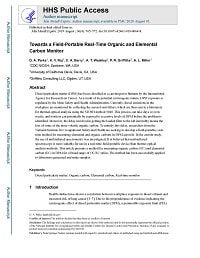Mining Publication: Towards a Field-Portable Real-Time Organic and Elemental Carbon Monitor
Original creation date: August 2019
Authors: D Parks, KV Raj, C Berry, AT Weakley, PR Griffiths, A Miller
Diesel particulate matter (DPM) has been classified as a carcinogen to humans by the International Agency for Research on Cancer. As a result of its potential carcinogenic nature, DPM exposure is regulated by the Mine Safety and Health Administration. Currently, diesel emissions in the workplace are monitored by collecting the aerosol onto filters, which are then sent to a laboratory for thermal-optical analysis using the NIOSH method 5040. This process can take days or even weeks, and workers can potentially be exposed to excessive levels of DPM before the problem is identified. Moreover, the delay involved in getting the loaded filter to the lab inevitably means the loss of some of the more volatile organic carbon. To remedy this delay, researchers from the National Institute for Occupational Safety and Health are seeking to develop a field-portable, real-time method for measuring elemental and organic carbons in DPM aerosols. In the current study, the use of mid-infrared spectrometry was investigated. It is believed that mid-infrared spectroscopy is more suitable for use in a real-time field-portable device than thermo-optical analysis methods. This article presents a method for measuring organic carbon (OC) and elemental carbon (EC) in DPM for a broad range of OC/EC ratios. The method has been successfully applied to laboratory-generated and mine samples.

- Aerosols Emitted in Underground Mine Air by Diesel Engine Fueled with Biodiesel
- A Computer Software Program that Estimates Air Quantity Requirements in Large Opening Stone Mines
- Diesel Exhaust Aerosol, Review of Measurement Technology
- The Effects of Water Emulsified Fuel on Diesel Particulate Matter Concentrations in Underground Mines
- Evaluating Portable Infrared Spectrometers for Measuring the Silica Content of Coal Dust
- The Fate of Metal (Fe) During Diesel Combustion: Morphology, Chemistry, and Formation Pathways of Nanoparticles
- Feasibility Study For a Novel Field-Portable DPM Monitor
- A Predictive Model for Elemental Carbon, Organic Carbon and Total Carbon Based on Laser Induced Breakdown Spectroscopy Measurements of Filter-collected Diesel Particulate Matter
- Quantifying Elemental and Organic Carbon in Diesel Particulate Matter by Mid-infrared Spectrometry
- Technology News 514 - The Air Quantity Estimator (AQE): A New Computer Software Tool for Large-opening Mine Ventilation Planning